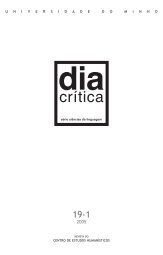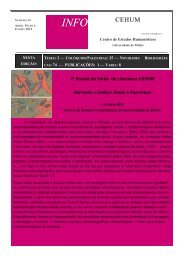Revista (PDF) - Universidade do Minho
Revista (PDF) - Universidade do Minho
Revista (PDF) - Universidade do Minho
Create successful ePaper yourself
Turn your PDF publications into a flip-book with our unique Google optimized e-Paper software.
THE CASE FOR STAKEHOLDING 219<br />
campaign for reelection. Under his proposal, every infant born in<br />
Britain would receive a «baby bond» worth up to $750, which would<br />
mature when he or she reached 18. The Treasury would make additional<br />
deposits in each child’s account when he reaches 5, 11 and 16.<br />
Thanks to compound interest, young adults would start life with as<br />
much as $7,500. Obviously, $7,500 isn’t quite $80,000; and the lengthy<br />
18 year transition before the first child gets his stake is much too<br />
long for my taste. 3 Nonetheless, when Blair’s proposal is approved by<br />
parliament, it will mark a great step forward for my project. Once a<br />
stakeholding framework in put in place in Britain, there will be inevitable<br />
agitation for higher stakes and shorter transition periods. So let<br />
us consider some basic principles that should inform future efforts,<br />
using my more ambitious program as a reference point.<br />
First and foremost, stakeholders should be treated as free men and<br />
women. They may use their money for any purpose they see fit – to<br />
start a business or pay for higher education, to buy a house or raise a<br />
family or save for the future. But they must take responsibility for their<br />
choices. Their triumphs and blunders are their own.<br />
At the end of their lives, stakeholders have a special responsibility.<br />
Since the $80,000 was central in starting them off in life, it is only fair<br />
for them to repay it at death if this is financially possible. The stakeholding<br />
fund, in short, will be enriched each year by the ongoing contributions<br />
of the wealthy, and by a final payback at death.<br />
I have chosen $80,000 as the target stake because this is the cost<br />
of a high quality, four year university education in America today.<br />
For the 25 or 30 percent going to university, a key policy question is<br />
whether we will continue with a policy of subsidized tuition now<br />
that each student has the financial capacity to pay his way. This is a<br />
complex issue, and I would be happy to discuss it further in the<br />
question period.<br />
But for now, I want to emphasize a key point: Even if you<br />
ultimately decide that university students should pay most or all of<br />
their stake as tuition, this should serve only as a prelude to further<br />
discussion. After all, stakeholding offers unprecedented opportunities<br />
for the vast majority who <strong>do</strong>n’t go to university. Many of them have<br />
been denied the decent secondary school education that should be every<br />
——————————<br />
3 The most thoughtful effort to adapt stakeholding to the British context is by<br />
David Nissan and Julian Le Grand, A Capital Idea: Start-Up Grants for Young People,<br />
Fabian Society Policy Report No. 49, Feb. 2000 (www.fabian-society.org.uk).











![Programa [pdf] - cehum - Universidade do Minho](https://img.yumpu.com/17305425/1/190x135/programa-pdf-cehum-universidade-do-minho.jpg?quality=85)




